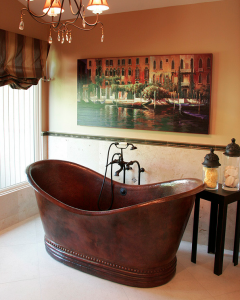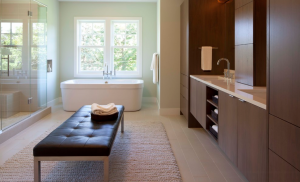FIVE YEARS AGO, Tamara Kaye-Honey had a $4,000 freestanding tub delivered to the un-renovated attic of her 1920s gabled Los Angeles Tudor. “I’d brave the rickety old plank stairs, perch in the empty tub and sketch floor plans,” recalled the interior designer and mother of two. Now her newly finished master bath, with mountain views from the tub and furnishings befitting a soignée dressing room is her guilty-pleasure sanctuary. “I spend lots of time just sitting in a chair with a glass of wine reading, listening to music and maybe hiding out from my kids,” Ms. Kaye-Honey confessed.
“The freestanding tub is my muse,” she said of her modern Victoria + Albert soaker made of volcanic limestone and resin. “It gives the bathroom a sense of sophistication.”
Whether it’s a traditional design steeped in British country-house charm that recalls the less debauched parts of “Brideshead Revisited,” or a contemporary model that conjures minimalist spas, the freestanding tub has a newfound stature as the focal point in today’s more ambitious bathrooms.
Sales are approaching a high-water mark: Of designers who belong to the National Kitchen and Bath Association, more than 60% polled in a 2013 report said they ordered freestanding tubs for bathroom projects, up 7% over 2012, with their choices “trending toward contemporary and transitional styles,” rather than antique looks, said NKBA president John Petrie.
Manufacturers are hustling to meet growing demand. In 2008 the California-based Hydro Systems offered only two freestanding tubs; today it has 35 styles. High-profile designers are also testing the waters: Philippe Starck, Marcel Wanders and Patricia Urquiola have created stand-alone tubs for European manufacturers, while Wisconsin-based Kallista has introduced a line by Michael S. Smith.
Though built-in tubs are less expensive and take up less space, they don’t promote unbridled fantasy nearly as efficiently. “A built-in tub can feel a bit utilitarian, while a freestanding tub conveys the Old World feeling that relaxation is taken seriously,” said designer Timothy Corrigan, who purchased the Château du Grand-Lucé in France’s Loire Valley and grandly eliminated half of its 32 bedrooms to create bathrooms complete with original 18th-century fireplaces and historically appropriate antiques.
Sales for whirlpool tubs, once a popular indulgence, are also circling the drain. “When you have a bath, you are looking for quiet. A noisy whirlpool does not take you to a serene spa space,” said Barbara Sallick, co-founder of Waterworks, a popular source of high-end bathroom-fittings. This year, the company has seen a 13% rise from 2013 in purchases of freestanding tubs, which represent over half of its tub offerings and account for nearly 75% of its bathtub sales.
Over time, architects building new homes have increasingly seen the master bathroom not just as a glorified closet but as a room unto itself, said Ms. Sallick, who, inspired by the un-humble bathrooms in London’s Savoy Hotel, started Waterworks in 1978. “Even in older homes,” she said, “designers might borrow space from a closet or an adjoining guest room to create a private retreat with furniture, where you can imagine one person in the tub and one in a chair.”
That kind of civility—the antithesis of showering briskly while being assaulted by a firing squad of jets—was what Annie Selke‚ owner of Pine Cone Hill bedding and Dash & Albert rugs, had in mind when she converted a guest room in a Berkshires, Mass., farmhouse into a master bath. “I wanted to create a pleasing space reminiscent of English and Irish [bathrooms], which had real personality because they looked like sitting rooms,” she said. “My favorite memories of this house are sitting in the tub while my daughter sat in a comfy chair and told me about her day.”
L.A. architect Erik Evens had similar goals when he converted a secondary bedroom in a historic Pasadena, Calif., house into what he calls a “Moroccan fantasy, complete with a canopied bathtub.” In his view, “people are finding value in baths that are rooms not mere workspaces, nurturing destinations instead of clinical places.”
Of course, a bathroom big enough to accommodate a tub in its center often has room for furniture beyond a single vanity stool, increasing the scope for decorating. L.A. designer Peter Dunham, who uses freestanding tubs to echo the graciousness of British country homes, sees such spaces as more than “just a place to clip your fingernails,” and considers “sofas, area rugs, art and non-bathroomy furniture” fully appropriate appointments.
“I have begun to think of the bathroom as I do any other furnished room,” said Santa Monica, Calif.-based interior designer Tim Clarke. “The bathtub has become like a sofa; you don’t want it to feel like an elephant, so you need plenty of space. With a freestanding tub, it’s possible to furnish around it with pull-up tables, chairs and lamps.”
Injecting a bathroom with coziness creates a nice tension between practicality and geniality. “I love furniture in a bathroom because even a simple wooden chair and a vintage rug provide such a contrast to cold, hard tile and stone,” said fellow Californian designer Betsy Burnham, who recently installed a classic boat-shaped tub by the British manufacturer Drummonds in a 1920s Los Angeles home.
 Because freestanding tubs come in such a variety—cast-iron, high-backed, Victorian-style slipper tubs; Asian-influenced wooden boxes; minimalist Italian-marble troughs—they can set a more distinctive design tone for a room than built-ins, which have a clunky, cookie-cutter look, Ms. Burnham added. “The fantasy is always to be transported somewhere else,” she said. “That riad you loved on a recent trip to Morocco, a grandparents’ house in the country that’s a memory from childhood, a comfy bed-and-breakfast at the beach.”
Because freestanding tubs come in such a variety—cast-iron, high-backed, Victorian-style slipper tubs; Asian-influenced wooden boxes; minimalist Italian-marble troughs—they can set a more distinctive design tone for a room than built-ins, which have a clunky, cookie-cutter look, Ms. Burnham added. “The fantasy is always to be transported somewhere else,” she said. “That riad you loved on a recent trip to Morocco, a grandparents’ house in the country that’s a memory from childhood, a comfy bed-and-breakfast at the beach.”
Evoking a sense of time, not place, was the aim for Charlotte Starling, the owner of Velvet & Dash Interiors in Dorset, England, when she transformed a bedroom in her 1700s house into a bath. “I wanted something that felt ‘Downton Abbey,’ ” she said, “that era when a maid would have drawn you a bath.” She selected a freestanding tub, “the longest one they had, so you could almost lie flat,” and had the plumbing routed through newly reinforced joists to the center of the room. Deviating from the conventional wisdom that the tub should be set on a water-resistant surface, Ms. Starling  retained the historic wooden floorboards but also installed a practical glass-enclosure shower in the corner of the room. She painted the walls a romantic pale pink and added a Victorian nursing chair from her husband’s childhood bedroom.
retained the historic wooden floorboards but also installed a practical glass-enclosure shower in the corner of the room. She painted the walls a romantic pale pink and added a Victorian nursing chair from her husband’s childhood bedroom.
The siren song of the freestanding tub also seduced design writer Kate Watson-Smyth, who installed one during the renovation of her North London home. “I love the promise of that bath. It’s the ultimate luxury, but I never use it,” she admitted. “Just the idea of it is enough for me. My husband does like a Saturday afternoon soak though.”
Though Mr. Dunham has observed that “men generally gasp when their wives want a tub that costs as much as a small car,” some guys have started to splash out. “In houses with his and hers bathrooms, we are starting to get requests for men’s tubs,” said Mr. Corrigan. “Five years ago this almost never happened.”
English artist Julian Kalinowski has always been an ardent bather. He turned a bedroom in a Georgian house in Kent into a luxurious personal statement with a claw-foot slipper tub, a sink set into a Victorian sewing table, painted wooden shutters, a table for books and a display case for vintage toys. “The fantasy was that I would lie in the bath, read a nice book, smoke cigarettes and drink champagne whilst occasionally dreamily staring out the window at the moon beyond the trees in the garden. And that,” he said, “is precisely the reality.”
BEYOND THE BUILT-IN // Stand-alone tub tips from top designers
The Costs:
Prepare to take a financial bath. Freestanding tubs can easily start at 2-3 times the price of comparable built-ins. You should also budget for additional plumbing and carpentry costs and labor. “You want to make sure that the floor is strong enough,” said Los Angeles designer Kerry Joyce, “as larger tubs full of water can easily weigh 1,000 pounds.” The fittings are also pricier than those hidden behind walls, added Los Angeles-based designer Betsy Burnham: “They’ll likely be a focal point and not only need to function well, but also look beautiful from all angles.”
The Planning:
Besides the extra space needed for a freestanding tub, which can exceed six feet in length, “you also need to consider special flooring because the area around the tub will get quite wet,” Ms. Burnham said. “Wood floors can get ruined, and large-format tile and stone can be slippery.” (She recommends 1- or 2-inch hexagonal tiles; the grout provides traction.) Consider a floor drain in case of overflows. Take advantage of a view where possible, Mr. Joyce advised: “I often position tubs in front of large windows.”
The Selection:
“The quality of enameled cast-iron is incredible, as it lasts forever, but that’s a very specific traditional look,” said L.A. designer Joan Behnke. Synthetics and stone composites are warmer to the touch and can be sculpted into more contemporary shapes in matte or glossy finishes. Metal tubs hold heat well—freestanding tubs are not typically insulated—but copper will oxidize without polishing, said Waterworks’ co-founder Barbara Sallick. For a low-maintenance organic feeling, wood and solid stone tubs have a natural beauty. Finally, be willing to take a preliminary dip to ensure comfort, said Dallas designer Jan Showers: “Clients like to get in the tubs when we’re shopping, which is a great idea.
